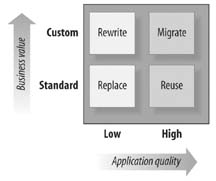6.1. Migrate, Replace, Rewrite, or Reuse?
| Once an organization has decided that a certain application no longer meets its business needs and that doing nothing is no longer an option, modernization comes into play.[1] There are at least four ways to approach the modernization of a VB application that should be considered. The deciding factors are:
Quality in this case is about the suitability of the application in business and technical terms and should be assessed in accordance with the following parameters:
The business value of the application is another important consideration and this will depend to a considerable degree on its uniqueness. If the quality of the application is poor and there is comparable functionality available in a third-party software package, it makes sense to replace it. There are four broad modernization options migrate, re-use, rewrite, or replace any one of which can be the right choice either for a complete application or for parts of an application. Figure 6-1 shows how the decision factors correlate with the modernization path.
6.1.1. Making the Right DecisionUpon the initiation of the project you should prepare a feasibility analysis that provides an assessment of the business and technical quality of the application. The following series of checklists presents some of the questions that you should consider when choosing one of the alternatives. 6.1.1.1. MigrateBelow is the checklist for choosing to migrate:
6.1.1.2. ReuseBelow is the checklist for choosing to reuse:
6.1.1.3. RewriteBelow is the checklist for choosing to rewrite:
6.1.1.4. ReplaceBelow is the checklist for choosing to replace:
The preceding questions can apply to complete applications or to discrete parts of applications. Typically a large application will require use of more than one modernization alternative. When deciding the best path for a particular part of an application, bear in mind that many developers will invariably say that rewriting your application is the best solution if you need to upgrade it, because they usually feel they can write it better the second time, armed with the benefit of hindsight. Certainly if the application is poorly designed, rewriting it can be a good option because it provides an opportunity to do it right. However, examining the business case for upgrading, rewriting, replacing, or leaving the application in Visual Basic 6.0 always provides some interesting insights. If the application already supports your business needs, doesn't require enhancements to its functionality, and if you already have support staff trained in VB 6, then leaving the application in VB 6 is a good option. Nevertheless, your organization needs to assess the risks of this approach in light of current lifecycle guidelines from Microsoft and the opportunities that the VB 2005 and .NET framework offer to your organization. If there is a business need to move the application to VB 2005, then there is a need to look more closely at rewriting versus upgrading. Upgrading the application using the VB 6 to VB 2005 migration tool is a cost-effective way to migrate your applications. One popular reason for moving an application to VB 2005 is to either web-enable the application, or to enhance an existing web-enabled application with ASP.NET features such as tracing, flexible state management, scaleable data access, and improved performance. As mentioned previously, rewriting sometimes yields an improved application. The downside is that the development cost will be much greater than upgrading. There are some benefits to rewriting. Rewriting allows you to correct a poor design, and COM objects can be replaced with .NET objects that are more scaleable and don't require registration during deployment. The flipside of this is that upgrading is much quicker and COM objects can be replaced with .NET objects after the upgrade has taken place. In brief, you have to decide on how to move forward with your modernization project. If you decide that the best solution is to leave the application in VB 6, then you are done! On the other hand, if you have assessed that the best solution is to rewrite your application, then the best piece of advice is to make sure that you follow an accepted development methodology and that you really look back at the issue your current application has to make sure you can leverage that knowledge when moving forward. If you think your current application and its source code have value, and that by moving it to .NET you can extend its lifecycle, then you have decided that automatically assisted migration is the best solution for your code. Finally, you may decide to go for a combination of the above solutions, as is the case for most modernization projects. |
EAN: 2147483647
Pages: 86
